The Economics and Statistics Division maintains archives of previous publications for accountability purposes, but makes no updates to keep these documents current with the latest data revisions from Statistics Canada. As a result, information in older documents may not be accurate. Please exercise caution when referring to older documents. For the latest information and historical data, please contact the individual listed to the right.
<--- Return to Archive
For additional information relating to this article, please contact:
March 27, 2025JOB VACANCIES, JANUARY 2025 Monthly (January 2025 vs December 2024 vs, seasonally adjusted)
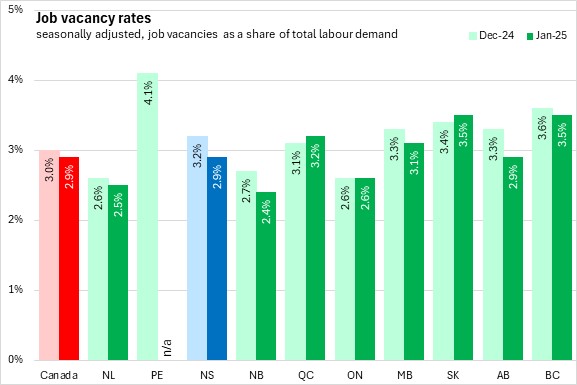
Nova Scotia had 13,445 job vacancies in January 2025 with a vacancy rate of 2.9%. Nova Scotia's vacancy rate was down from 3.2% in December. Canadian employers were actively recruiting for 526,165 positions in January with a vacancy rate of 2.9%. The national job vacancy rate edged down from 3.0% in December 2024. Six provinces reported lower vacancy rates from the previous month (Prince Edward Island data was suppressed in January 2025). The highest vacancy rate was reported in Saskatchewan and British Columbia, while the lowest vacancy rate was reported in New Brunswick. The job vacancy rate was unchanged in Ontario.
When compared to December 2024, the number of job vacancies in Nova Scotia fell 8.5% (-1,250 jobs). National job vacancies declined 2.5% (-13,505 jobs). Job vacancies fell in seven provinces with the fastest decline in Alberta. Québec and Saskatchewan reported higher vacancies compared to December.
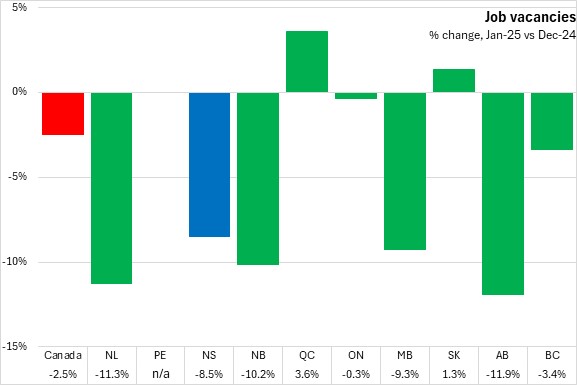
Year-over-year (January 2025 vs January 2024)
When compared to January 2024, the job vacancy rate in Nova Scotia declined 0.3 percentage points. Nationally, the job vacancy rate declined from 3.7% to 2.9%. All provinces (except Prince Edward Island, where January 2025 data were suppressed) reported lower job vacancy rates compared to one year ago.
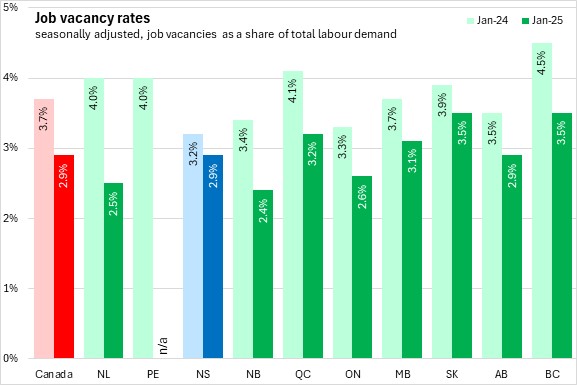
When compared to January 2024, the number of job vacancies in Nova Scotia declined 9.8% or 1,465 vacancies. National job vacancies declined 20.6% or 136,740 vacant jobs. All provinces reported declines in the number of vacancies over the twelve-month period ending in January (except Prince Edward Island, where monthly data were suppressed). In percentage terms, Newfoundland and Labrador declined the most compared to January 2024, and Saskatchewan and Nova Scotia the least.
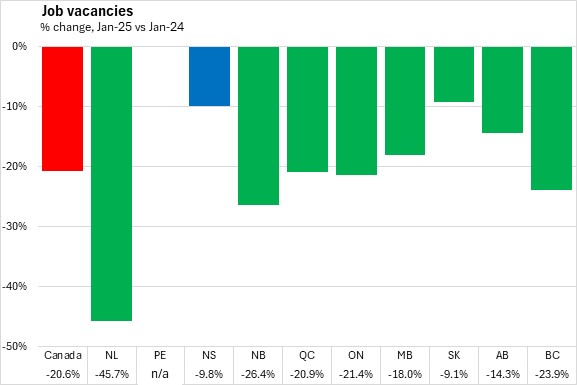
Trend
Nationally, job vacancy rates have trended downward after peaking in March-May 2022.
Nova Scotia's job vacancy rate peaked in the spring of 2022 and has also been on a downward trend. The Nova Scotia job vacancy rate has been below the national rate for most of this period.
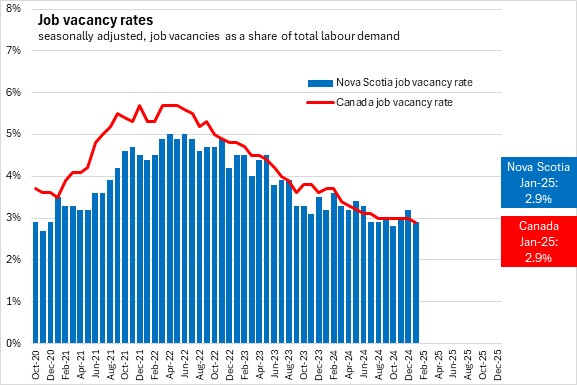
Nova Scotia's job vacancies peaked at 22,715 in June 2022 and have been trending down. Job vacancies have declined at a slower pace since the end of 2023.
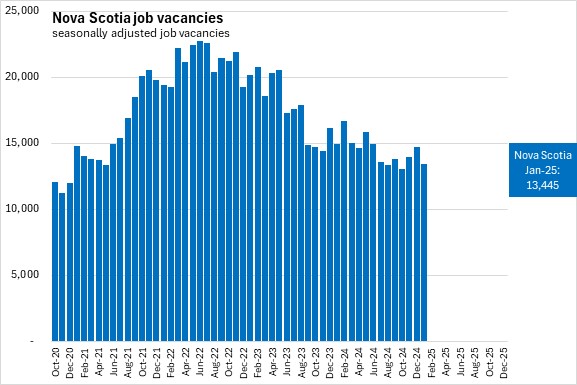
Canada job vacancy rate and job vacancies by industry, January 2025
Nationally, accommodation/food services, health care/social assistance, and personal/repair services had the highest job vacancy rates. The lowest vacancy rates were in utilities and education. All industry sectors reported lower vacancy rates compared to one year ago.
Health care and social assistance had the highest number of vacancies at 109,230 in January 2025. Compared to January 2024, the number of vacancies declined in every industry.
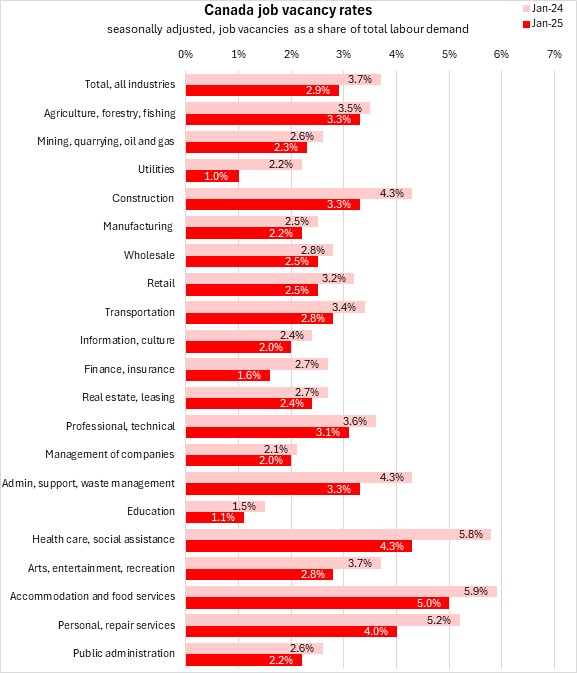
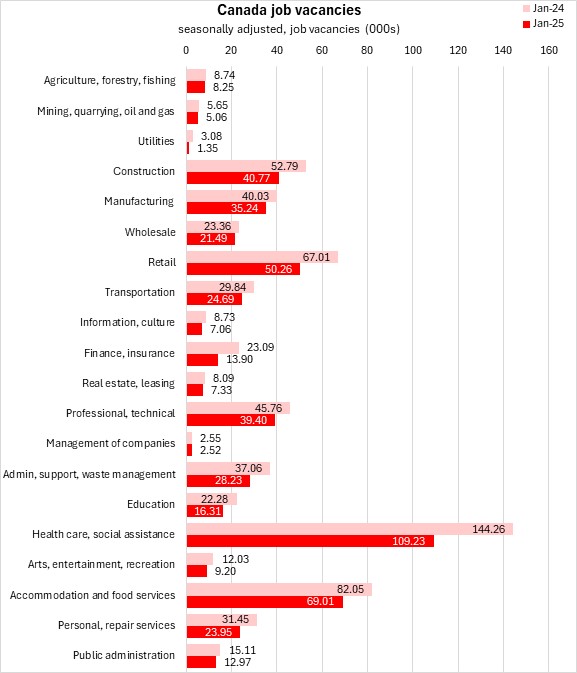
Notes: The job vacancy rate is the percentage of job positions (both filled and vacant) that are vacant. A higher job vacancy rate indicates a tighter labour market where it is more difficult for employers to find suitable candidates for the positions offered. A lower job vacancy rate signals labour market slack and potentially more job seekers competing for each vacant position.
During the COVID-19 pandemic, data collection was suspended from April to October 2020. There remains a break in this data series.
Sources: Statistics Canada, Table 14-10-0432-01 Job vacancies, payroll employees, and job vacancy rate by provinces and territories, monthly, adjusted for seasonality, Table 14-10-0406-01 Job vacancies, payroll employees, and job vacancy rate by industry sector, monthly, adjusted for seasonality
<--- Return to Archive